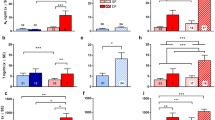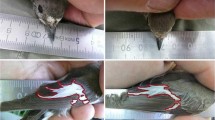Abstract
Although there is increasing interest in the evolution of endocrine systems, relatively little is known about the factors associated with natural endocrine variation in invertebrates. Here, we assess juvenile hormone (JH) titers among nest-founding queens of the wasp Polistes dominulus over 2 years. We allowed unfamiliar wasps to battle for dominance and examined the relationships between dominance rank, JH, ovarian development, and facial patterns. The relationship between JH-titer and dominance varied across years; there was a stronger relationship between JH-titer and dominance in 2006 than in 2008. Across years, wasps that won dominance contests had facial patterns with more broken black spots than wasps that lost dominance contests. There was no relationship between dominance rank and ovarian development. The individual characteristics associated with JH-titer were also tested; JH-titers were correlated with facial pattern brokenness and ovarian development. This study adds to previous work indicating that P. dominulus facial patterns function as a signal of fighting ability. Furthermore, the correlation between JH-titers and facial patterns parallels previous work on testosterone and vertebrate signals and suggests that links between signals of fighting ability and hormones that mediate fighting ability may be common across taxa. Overall, individual JH-titers vary, though they are typically associated with factors related to individual reproductive success, including dominance, fertility, and facial pattern brokenness. Future studies in additional contexts and taxa will be important to test how and why JH-titers vary.



Similar content being viewed by others
References
Adamo SA, Schildberger K, Loher W (1994) The role of the corpora allata in the adult male cricket (Gryllus campestris and Gryllus bimaculatus) in the development and expression of its agonistic behavior. J Insect Physiol 40:439–446
Adkins-Regan E (2005) Hormones and animal social behavior. Princeton University Press, Princeton
Bloch G, Borst DW, Huang ZY, Robinson GE, Cnaani J, Hefetz A (2000) Juvenile hormone titers, juvenile hormone biosynthesis, ovarian development and social environment in Bombus terrestris. J Insect Physiol 46:47–57
Bradbury J, Vehrencamp S (1998) Principles of animal communication. Sinauer Associates, Sunderland
Brent C, Peeters C, Dietmann V, Crewe R, Vargo E (2006) Hormonal correlates of reproductive status in the queenless ponerine ant, Streblognathus peetersi. J Comp Physiol A Neuroethol Sens Neural Behav Physiol 192:315–320
Cervo R, Dapporto L, Beani L, Strassmann JE, Turillazzi S (2008) On status badges and quality signals in the paper wasp Polistes dominulus: body size, facial colour patterns and hierarchical rank. Proc R Soc B Biol Sci 275:1189–1196
Chaine AS, Lyon BE (2008) Adaptive plasticity in female mate choice dampens sexual selection on male ornaments in the lark bunting. Science 319:459–462
Chen YR, Chen SC, Chang HW, Sun G, Kou R (2005) Effect of exogenous juvenile hormone III and precocene II on agonistic behavior and the corpora allata in vitro activity in the male lobster cockroach Nauphoeta cinerea (Dictyoptera: Blaberidae, Oxyhaloinae). Zool Stud 44:409–416
Cockburn A, Osmond HL, Double MC (2008) Swingin' in the rain: condition dependence and sexual selection in a capricious world. Proc R Soc B Biol Sci 275:605–612
Cuvillier-Hot V, Lenoir A, Crewe R, Malosse C, Peeters C (2004) Fertility signalling and reproductive skew in queenless ants. Anim Behav 68:1209–1219
Dropkin JA, Gamboa GJ (1981) Physical comparisons of foundresses of the paper wasp, Polistes metricus (Hymenoptera, Vespidae). Can Entomol 113:457–461
Emlen DJ, Nijhout HF (2000) The development and evolution of exaggerated morphologies in insects. Annu Rev Entomol 45:661–708
Gill SA, Alfson ED, Hau M (2007) Context matters: female aggression and testosterone in a year-round territorial neotropical songbird (Thryothorus leucotis). Proc R Soc B Biol Sci 274:2187–2194
Giray T, Giovanetti M, West-Eberhard MJ (2005) Juvenile hormone, reproduction, and worker behavior in the neotropical social wasp Polistes canadensis. Proc Natl Acad Sci USA 102:3330–3335
Gonzalez G, Sorci G, Smith LC, de Lope F (2001) Testosterone and sexual signalling in male house sparrows (Passer domesticus). Behav Ecol Sociobiol 50:557–562
Hartfelder K (2000) Insect juvenile hormone: from "status quo" to high society. Braz J Med Biol Res 33:157–177
Hau M (2007) Regulation of male traits by testosterone: implications for the evolution of vertebrate life histories. Bioessays 29:133–144
Heinze J, Stengl B, Sledge MF (2002) Worker rank, reproductive status and cuticular hydrocarbon signature in the ant, Pachycondyla cf. inversa. Behav Ecol Sociobiol 52:59–65
Huang ZY, Robinson GE (1995) Seasonal-Changes in Juvenile-Hormone Titers and Rates of Biosynthesis in Honey-Bees. J Comp Physiol, B Biochem Syst Environ Physiol 165:18–28
Huang ZY, Robinson GE (1996) Regulation of honey bee division of labor by colony age demography. Behav Ecol Sociobiol 39:147–158
Huang ZY, Robinson GE, Borst DW (1994) Physiological correlates of division-of-labor among similarly aged honey bees. J Comp Physiol Sens Neural Behav Physiol 174:731–739
Izzo A, Wells M, Huang Z, Tibbetts E (2010) Cuticular hydrocarbons correlate with fertility, not dominance, in a paper wasp, Polistes dominulus. Behav Ecol Sociobiol 64:857–864
Jassim O, Huang ZY, Robinson GE (2000) Juvenile hormone profiles of worker honey bees, Apis mellifera, during normal and accelerated behavioural development. J Insect Physiol 46:243–249
Kasumovic MM, Bruce MJ, Andrade MCB, Herberstein ME (2008) Spatial and temporal demographic variation drives within-season fluctuations in sexual selection. Evolution 62:2316–2325
Ketterson ED, Nolan V, Wolf L, Ziegenfus C (1992) Testosterone and avian life histories - Effects of experimentally elevated testosterone on behavior and correlates of fitness in the Dark-Eyed Junco (Junco hyemalis). Am Nat 140:980–999
Kou R, Chou SY, Huang ZY, Yang RL (2008) Juvenile hormone levels are increased in winners of cockroach fights. Horm Behav 54:521–527
Liebig J (2010) Hydrocarbon profiles indicate fertility and dominance status in ant, bee, and wasp colonies. In: Blomquist GJ, Bagnères AG (eds) Insect Hydrocarbons: Biology, Biochemistry, and Chemical Ecology. Cambridge University Press
Monnin T (2006) Chemical recognition of reproductive status in social insects. Annales Zoologici Fennici 43:515–530
Mougeot F, Irvine JR, Seivwright L, Redpath SM, Piertney S (2004) Testosterone, immunocompetence, and honest sexual signaling in male red grouse. Behav Ecol 15:930–937
Nijhout HF (1994) Insect Hormones. Princeton University Press, New York
Nonacs P, Reeve HK (1995) The ecology of cooperation in wasps - Causes and consequences of alternative reproductive decisions. Ecology 76:953–967
Papeschi A, Briganti F, Dessi-Fulgheri F (2000) Winter androgen levels and wattle size in male Common Pheasants. Condor 102:193–197
Pardi L (1948) Ricerche sui Polistini. 11. Sulla durata della permanenza delle feminine nel nido e sull' accrescimento della societa in Polistes gallicus (L.). Atti della Societa Toscana di Scienze Naturali 1-15
Peeters C, Monnin T, Malosse C (1999) Cuticular hydrocarbons correlated with reproductive status in a queenless ant. Proc R Soc Lond B Biol Sci 266:1323–1327
Reeve HK (1991) Polistes. In: Ross KG, Matthews RW (eds) The Social Biology of Wasps. Comstock Publishing Associates, Ithaca, pp 99–148
Robinson GE, Vargo EL (1997) Juvenile hormone in adult eusocial hymenoptera: Gonadotropin and behavioral pacemaker. Arch Insect Biochem Physiol 35:559–583
Röseler PF (1991) Reproductive competition during colony establishment. In: Ross KG, Matthews RW (eds) The social biology of wasps. Comstock publishing associates, London, pp 309–335
Röseler PF, Röseler I, Strambi A, Augier R (1984) Influence of insect hormones on the establishment of dominance hierarchies among foundresses of the paper wasp Polistes gallicus. Behav Ecol Sociobiol 15:133–142
Röseler PF, Röseler I, Strambi A (1985) Role of ovaries and ecdysteroids in dominance hierarchy establishment among foundresses of the primitively social wasp, Polistes gallicus. Behav Ecol Sociobiol 18:9–13
Scott MP (2006a) Resource defense and juvenile hormone: The "challenge hypothesis" extended to insects. Horm Behav 49:276–281
Scott MP (2006b) The role of juvenile hormone in competition. and cooperation by burying beetles. J Insect Physiol 52:1005–1011
Senar JC (2006) Color displays as intrasexual signals of aggression and dominance In: Hill GE, McGraw KJ (eds) Bird Coloration Function; and Evolution, vol 2. Harvard University Press, London, pp 87–136
Shorter JR, Tibbetts EA (2009) The effect of juvenile hormone on temporal polyethism in the paper wasp Polistes dominulus. Insect Soc 56:7–13
Sledge MF, Boscaro F, Turillazzi S (2001) Cuticular hydrocarbons and reproductive status in the social wasp Polistes dominulus. Behav Ecol Sociobiol 49:401–409
Sledge MF, Trinca I, Massolo A, Boscaro F, Turillazzi S (2004) Variation in cuticular hydrocarbon signatures, hormonal correlates and establishment of reproductive dominance in a polistine wasp. J Insect Physiol 50:73–83
Sommer K, Holldobler B, Rembold H (1993) Behavioral and physiological aspects of reproductive control in a Diacamma species from Malaysia (Formicidae, Ponerinae). Ethology 94:162–170
Tibbetts EA (2008) Resource value and the context dependence of receiver behaviour. Proc R Soc B Biol Sci 275:2201–2206
Tibbetts EA (2010) The condition-dependence and heritability of signaling and non-signaling color traits in paper wasps. Am Nat 175:495–503
Tibbetts EA, Dale J (2004) A socially enforced signal of quality in a paper wasp. Nature (London) 432:218–222
Tibbetts EA, Huang ZY (2010) The challenge hypothesis in insects: juvenile hormone mediates reproductive conflict following queen loss in Polistes paper wasps. American Naturalist 176
Tibbetts EA, Izzo M (2009) Endocrine mediated phenotypic plasticity: condition-dependent effects of juvenile hormone on dominance and fertility of wasp queens. Horm Behav 56:527–531
Tibbetts EA, Izzo M (2010) Social punishment of dishonest signalers caused by mismatch between signal and behavior Current Biology
Tibbetts EA, Lindsay R (2008) Visual signals of status and rival assessment in Polistes dominulus paper wasps. Biol Lett 4:237–239
Tibbetts EA, Safran RJ (2009) Co-evolution of black plumage patches and winter sociality in new and old world sparrows. J Evol Biol 22:2376–2386
Tibbetts EA, Shorter JR (2009) How do fighting ability and nest value influence usurpation contests in Polistes wasps? Behav Ecol Sociobiol 63:1377–1385
Tibbetts EA, Mettler A, Levey S (2010) Mutual assessment via visual status signals in Polistes dominulus wasps. Biol Lett 6:10–13
Turillazzi S, Pardi L (1977) Body size and hierarchy in polygynic nests of Polistes gallicus (Hymenoptera-Vespidae). Monit Zool Ital 11:101–112
West-Eberhard M (1969) The social biology of polistine wasps. Miscellaneous Publications of the Museum of Zoology University Michigan 140:1-101
Wingfield JC, Hegner RE, Dufty AM, Ball GF (1990) The challenge hypothesis - Theoretical implications for patterns of testosterone secretion, mating systems, and breeding strategies. Am Nat 136:829–846
Zera AJ, Zhao Z, Kaliseck K (2007) Hormones in the field: Evolutionary endocrinology of juvenile hormone and ecdysteroids in field populations of the wing-dimorphic cricket Gryllus firmus. Physiol Biochem Zool 80:592–606
Zuk M, Johnsen TS, Maclarty T (1995) Endocrine-immune interactions, ornaments and mate choice in Red Jungle Fowl. Proc R Soc Lond B Biol Sci 260:205–210
Acknowledgments
Funding was provided by the University of Michigan and Michigan State University Agricultural Experimental Station. The JH anti-serum was generous gift from David Borst. Thanks are due to A. Mettler, J. Shorter, and M. Wells for research assistance as well as two anonymous reviewers for helpful suggestions.
Author information
Authors and Affiliations
Corresponding author
Additional information
Communicated by O. Rueppell
Rights and permissions
About this article
Cite this article
Tibbetts, E.A., Izzo, A. & Huang, Z.Y. Behavioral and physiological factors associated with juvenile hormone in Polistes wasp foundresses. Behav Ecol Sociobiol 65, 1123–1131 (2011). https://doi.org/10.1007/s00265-010-1126-6
Received:
Revised:
Accepted:
Published:
Issue Date:
DOI: https://doi.org/10.1007/s00265-010-1126-6




